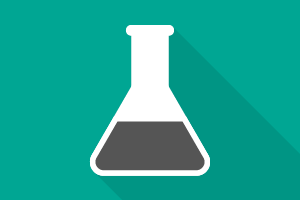Classroom Resources: Reactions & Stoichiometry
Filter by:
26 – 50 of 143 Classroom Resources
-

Reaction Rate, Reaction Rate | Middle School, High School
Activity: Simulation Activity: Investigating Reaction Rates
In this simulation, students will have the opportunity to investigate several factors that can affect the initial rate of a chemical reaction. Students will have the opportunity to manipulate several variables including concentration, temperature, or surface area of the reactants as well as the addition of a catalyst during the simulation. These reaction rates will be compared to a controlled reaction. Students will interpret a simplified qualitative representation of the reaction as well as analyze corresponding data organized on a graph.
-

Conservation of Mass, Measurements | Middle School, High School
Lab: Mass of a Gas
In this lab, students will perform a simple chemical reaction in a closed system to produce a small amount of gas. They will collect mass measurements for the reactants and the products in order to demonstrate the conservation of mass during the reaction. They will also release the produced gas from the closed system in order to verify that gasses have mass.
-

Classification of Reactions, Chemical Change, Solubility Rules, Net Ionic Equation | High School
Demonstration: Precipitation Reaction
In this demonstration, students will observe a precipitation reaction. Students will create several particle diagrams in order to describe and fully understand what is occurring on the atomic level during the chemical reaction.
-

Stoichiometry, Balancing Equations, Classification of Reactions | High School
Activity: Simulation Activity: Chemical Reactions and Stoichiometry
In this simulation, students will participate in a short quiz that challenges their knowledge of three related topics: classification of reaction types, balancing equations and solving stoichiometry problems.
-

Classification of Reactions, Balancing Equations, Stoichiometry, Redox Reaction, Net Ionic Equation | High School
Lab: Inquiry Redox Investigation
In this lab, students perform a simple redox reaction using an iron nail and copper(II) chloride solution. They will consider both quantitative and qualitative data collected during the reaction in order to attempt to explain what happened. Students will also create particle diagrams and determine mole ratios of various species in the reaction.
-

Classification of Reactions, Balancing Equations, Combustion, Reversible Reactions, Stoichiometry | High School
Demonstration: Firefighter or Fireball
In this demonstration the teacher will complete two chemical reactions inside of separate balloons that each produces a gas. Students will observe and record data as the teacher attempts to ignite each balloon. This demonstration will help students better understand how to predict products, as well as familiarize them with double replacement and combustion reactions.
-

Solubility Rules, Chemical Change, Redox Reaction, Precipitate, Reaction Rate, Reduction, Oxidation | High School
Lesson Plan: Removing Copper Stains from Masonry
In this lab, students investigate the use of milk of magnesia poultice to remove copper stains on masonry in copper architecture. They use chalk as the model for masonry, copper(II) chloride solution as a model for soluble copper and a freshly prepared slurry of copper phosphate as a model for a hard stain of copper on masonry. Through a series of investigations students have the opportunity to connect chemistry topics with real-world applications, such as environmental hazards, engineering practices of copper architecture, corrosion control, and structural protection.
-

Electricity, Renewable Energy, Photosynthesis, Electron Transfer, Redox Reaction, Oxidation, Reduction | High School
Lesson Plan: Color Solar Power!
In this lesson students will make a dye-sensitized solar cell (also known as DSC or Gratzel cell) using extracts from blackberries, raspberries, blueberries, red cabbage, strawberries, beetroot, spinach and dried hibiscus petals. Students will measure the voltage and the current of various light sources using the created solar cells and then compare the effectiveness of each.
-

Electron Configuration, Precipitate, Balancing Equations, Electrons, Valence Electrons, Solubility Rules, Classification of Reactions | High School
Lesson Plan: Transition Metals Color the World
In this lesson students will complete a series of double replacement reactions to form precipitates. The precipitates will be used as a pigment to create paint.
-

Chemical Change, Beer's Law, Redox Reaction, Reduction, Oxidation, Concentration, Reaction Rate | High School
Lesson Plan: Rustbusters! A Lab Activity on Corrosion
In this lesson students learn about factors affecting the rate of corrosion and evaluate the efficiency of different protective coatings to simulate products used in industry when building metal structures like ships or bridges.
-

Activity Series, Chemical Change, Redox Reaction, Reduction, Oxidation, Balancing Equations | High School
Lesson Plan: Single Displacement Reactions with Test Tube Diagrams
In this lesson students will perform and analyze two single displacement reactions and prepare and manipulate Test Tube Diagrams to depict the activity at the molecular level. Using manipulatives representing individual ions, atoms and molecules for the various reactants and products, they will accurately represent species in the solid, gaseous and aqueous states by correlating the Test Tube Diagram to the complete ionic equation for each reaction. They will determine the reactants and products responsible for color, as well as identify which species is oxidized and which is reduced.
-

Solubility Rules, Classification of Reactions, Precipitate, Net Ionic Equation | High School
Lesson Plan: Do it Yourself Color!
In this lesson students will use solubility rules to predict whether the product of a double displacement or metathesis reaction will produce a precipitate. Students will then investigate a series of reactions to verify solubility rules. Finally students will determine the identity of unknown solutions based on experimental evidence.
-

Reaction Rate, Reaction Rate, Chemical Change | Middle School, High School
Demonstration: Comparing Rates of Reaction
In this demonstration, students observe the effect of temperature, concentration, and particle size on the rate of a chemical reaction.
-

Reaction Rate, Activation Energy, Catalysts, Combustion, Reaction Rate | High School
Demonstration: Rates of Reactions
In this series of demonstrations, students will be introduced to factors that affect the rates of chemical reactions. They will observe and record their observations, while also describing the rate-influencing factor for each demonstration as well as evidence supporting whether or not the reaction rate was increased or decreased by the factor.
-

Classification of Reactions, Chemical Change, Catalysts, Observations | Middle School, High School
Demonstration: Catalyst in Motion
This demonstration allows students to visualize how a catalyst can impact a chemical reaction. Students will also identify the products of a decomposition reaction, as well as determine if the reaction was endothermic or exothermic based on their observations.
-

Activity Series, Classification of Reactions, Chemical Change | High School
Lab: Investigating the Activity Series of Metals
In this lab, students will create an activity series of metals and predict whether or not single replacement reactions are likely to occur.
-

Stoichiometry, Mole Concept, Dimensional Analysis | High School
Lesson Plan: Map It Out!
In this lesson, students should be able to use a graphic organizer to help them solve stoichiometry problems. This lesson utilizes the Cornell note format.
-

Combustion, Balancing Equations, Stoichiometry | High School
Activity: Calculating Your Carbon Footprint
In this lesson, students apply their knowledge of writing and balancing chemical equations and stoichiometry calculations to estimate their carbon footprint. Students are also asked to reflect on their carbon footprint and what it means.
-

Le Châtelier's Principle, Reversible Reactions, Concentration | High School
Lab: Le Chatelier’s Soda
In this lab, students will observe how the equilibrium of a chemical reaction is affected when a change in pressure, temperature, and concentration is applied to the system.
-

Titrations, Indicators, Acid Base Reactions, Stoichiometry, Percent Composition | High School
Lab: The Egg-straordinary Issue
In this lab students will determine the percent composition of calcium carbonate contained in an eggshell by using a back titration in order to address a farmer’s concerns about his hen’s fragile eggs. Two versions of the student lab are included, a scripted version, and an inquiry version.
-

Balancing Equations, Conservation of Mass | Middle School, High School
Activity: Balancing Legos
In this activity students use Legos to model the reactants and products in a chemical reaction. They use these “atoms” and “molecules” to balance the chemical reaction in order to demonstrate the law of conservation of matter.
-

Balancing Equations, Conservation of Mass, Molecular Formula | Middle School, High School
Lesson Plan: Counting Atoms & Balancing Equations
In this lesson, students will learn how to count atoms and how to balance chemical equations using videos, simulations and games.
-

Gas Laws, Stoichiometry | High School
Lab: Carbonate Identification
In this lab students use gas laws and stoichiometry, along with some balloons and simple measuring tools, to identify a metal carbonate from a short list of possibilities.
-

Chemical Change, Exothermic & Endothermic | High School
Lab: Little Miss Muffet
In this lab, students make homemade glue from milk and compare it to commercial glue.
-

Exothermic & Endothermic, Heat, Temperature, Classification of Reactions | Middle School, High School
Lab: Determining Endothermic and Exothermic Reaction
In this lab, students will analyze evidence to determine if a chemical reaction releases energy and can be classified as an exothermic reaction or if it absorbs energy and can be classified as an endothermic reaction.